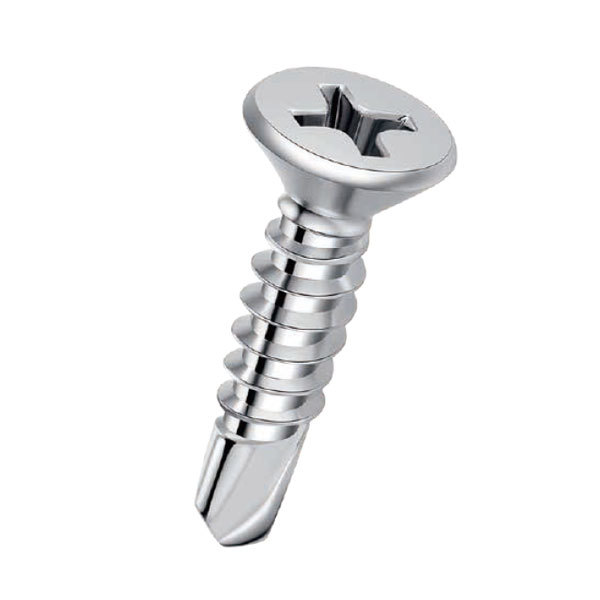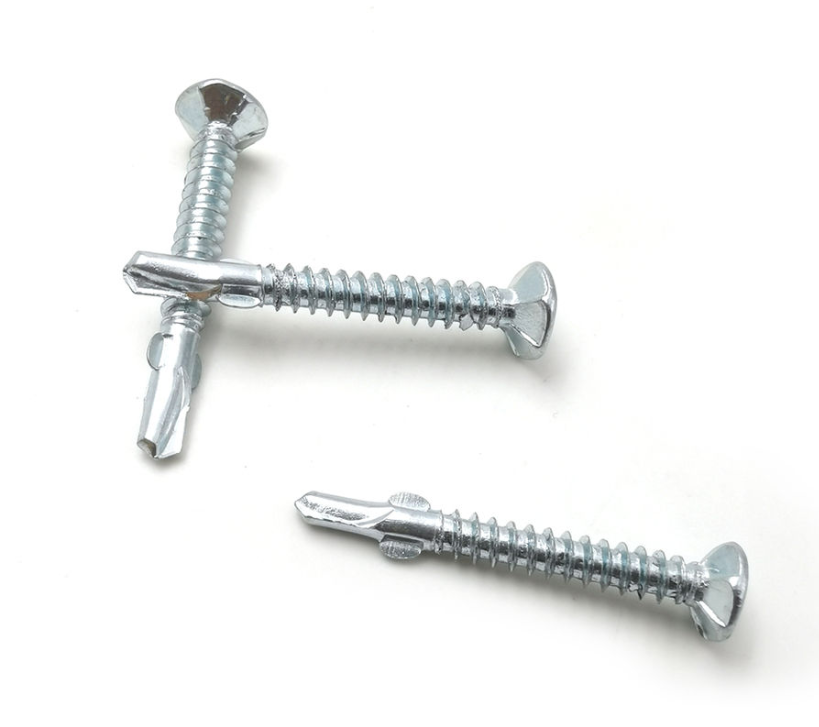VIS AUTOPERCEUSE TETE CSK
Head forming process: the head forming of CSK self-drilling screw requires accurate die and stamping process. In the manufacturing process, the screw head is stamped into a countersunk shape by a special mold, and the angle and dimensional accuracy of the conical part of the head should be ensured. Generally speaking, the angle of the head is between 80-90 degrees. This angle is designed to make the head sink into the material better, and at the same time ensure the adaptability with materials with different thicknesses.
Drilling tip and thread processing technology: the drilling tip of CSK self-drilling screw is usually made of cemented carbide, and the sharpness and hardness of the drilling tip are ensured by precise grinding technology. In thread processing, thread rolling technology is often used, which can make the thread more uniform and accurate and improve the strength of the thread. At the same time, in order to ensure the self-drilling function, the initial part of the thread will be specially designed to make it transition naturally with the drill tip part, which is convenient for smooth cutting and chip removal when drilling into materials.
-

Les vis autoperceuses à tête cruciforme Csk sont des fixations à haute résistance et durables utilisées pour les applications de tôlerie. Pour assurer un assemblage parfait, la variante à tête fraisée de la vis cruciforme doit être utilisée en conjonction avec un trou fraisé. L'utilisation de ces vis nécessite un trou pré-percé. Les vis elles-mêmes sont filetées avec une gradation torsadée qui facilite l'installation sur le trou pilote. Cela permet aux vis d'être utilisées dans des applications de haute précision telles que l'assemblage de machines et de composants électriques
-

Double flat head with Nibs under head self drilling screws
Comparison Between Csk Self-Drilling Screws and Flat Head Self-Drilling Screws
Appearance and surface effect after installation: After the CSK self-drilling screw is installed, the head completely sinks below the material surface, making the surface smoother. The head of the flat-headed self-drilling screw is flush or nearly flush with the surface of the material after installation. For example, when installing decorative strips on the surface of high-end wooden furniture, CSK self-drilling screws can completely hide the head, so that the surfaces of decorative strips can be seamlessly butted, which is more aesthetic; Flat head self-drilling screws may have slight edge marks.
Installation method and applicable scene emphasis: CSK self-drilling screw needs enough space for the head to sink during installation due to countersunk design. It has more advantages in some scenes that require high surface smoothness and aesthetics, such as fixing the shell of precision instruments. Flat-head self-drilling screws are more convenient to use in some occasions where the surface requirements are relatively less demanding and may need to be installed quickly, such as the fixing of common building templates.
Comparison Between Csk Self-Drilling Screws and Pan Head Self-Drilling Screws
Influence of head shape on space and appearance: the head of pan-head self-drilling screw protrudes from the material surface and has a large contact area. CSK self-drilling screws, on the other hand, do not occupy additional surface space. In the case of limited space, such as the internal circuit board of small electronic equipment is fixed, CSK self-drilling screws will not interfere with other components, while pan head self-drilling screws may limit the installation position of components. From the appearance, the pan head self-drilling screw is suitable for some occasions that have special requirements for decoration and allow the head to have a certain shape; CSK self-drilling screws focus on simple and flat appearance design.
Difference in fastening performance: During the tightening process of pan-head self-drilling screws, the larger head can disperse the pressure, but in some vibration environments, the protruding head may be more easily affected by external forces and become loose. The countersunk structure of CSK self-drilling screw makes the head closely attached to the surface of the material and has good anti-loosening performance when it is subjected to vibration. For example, in the fixing of parts near the automobile engine, CSK self-drilling screws can better resist the risk of loosening caused by engine vibration.
Performance of Csk Self-Drilling Screw in Special Environment
Wet environment: In wet environment, if CSK self-drilling screw is made of corrosion-resistant materials such as stainless steel, its countersunk structure can reduce the accumulation of water in the head. Compared with some screws with protruding heads, it is not easy to form puddles, thus reducing the risk of corrosion. For example, in the outdoor wooden structure fixation, such as the wooden plank road by the sea, CSK self-drilling screws can better resist the corrosion of seawater and humid air.
High temperature environment: In high temperature environment, the material properties of CSK self-drilling screws may be affected to some extent. However, because its head is immersed in material, the area directly radiated by high temperature is smaller than that of the screw with its head exposed. In the equipment fixing near some industrial furnaces, this structural feature can reduce the damage of high temperature to the structure and connection performance of screws to a certain extent.
Environment with chemical corrosion risk: When in an environment with chemical corrosion risk, such as a chemical workshop, CSK self-drilling screws can enhance their corrosion resistance by surface treatment (such as zinc plating and nickel plating). Moreover, the countersunk head design can prevent chemicals from accumulating on the head and reduce the occurrence of chemical corrosion. At the same time, the tight countersunk structure can also prevent chemical substances from infiltrating into the connection site to some extent, and protect the stability of the connection.



